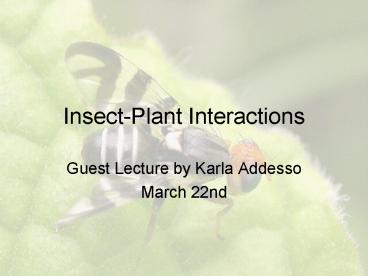InsectPlant Interactions - PowerPoint PPT Presentation
1 / 27
Title:
InsectPlant Interactions
Description:
Major diversification of many insect groups following ... that the direct value of honey bee pollination to U.S. agriculture is more than $14.6 billion. ... – PowerPoint PPT presentation
Number of Views:2100
Avg rating:3.0/5.0
Title: InsectPlant Interactions
1
Insect-Plant Interactions
- Guest Lecture by Karla Addesso
- March 22nd
2
Insects and Plantsa history
- 50 insects eat plants
- Major diversification of many insect groups
following Angiosperm diversification (160 mya)
3
What an insect gets out of it
- Food
- Pollen
- Nectar
- Foliage/other tissue
- Shelter
- Domatia
- Refugia (Enemy-Free Space)
- Oviposition sites
- Chemical compounds
4
What a plant gets out of it
- Pollination
- Protection from herbivores
- Seed transport
- Food?
5
The Insect Point of View
6
Plants Parts to Exploit
- Flowers (buds, ovaries, pollen, nectar)
- Fruits
- Leaves (old, young, meristem)
- Stem
- Roots
- Phloem, xylem (saps)
- Storage organs (tubers, seeds)
7
How do insects locate their host plant?
Taste receptors on tarsi, mouthparts, antennae
8
Timing is Everything
- Bud feeding insects hatching too long after bud
break
Bud feeding insects hatching too long before bud
break
Bud feeding insects hatching just as buds begin
to break
9
Sharing Resources Niche
differentiation
10
Nutrition from Plants
Insects Need Amino acids Carbohydrates Lipids,
fatty acids Vitamins Trace elements Sterols!! W
ater
Plants filled with water and cellulose
11
Digesting Plant Material Aphids, Guts Buchnera
- Aphid gut removes excess water and sugar from sap
and concentrates nutrients - Buchnera bacterial symbionts make amino acids and
vitamins Aphids cant - Aphids make nutrients Buchnera cant make
12
Sisterson and Gould 1999 (Ecology 80 1071-1075)
Plants as ShelterA refuge from parasitism for
Heliothis subflexa
Intact Tip removed
Melanie Bateman
7 48
13
Plants as Sources of Chemicals
- Defensive compounds Danus plexippus
(monarch) - Pheromones
- Nuptial Gifts- Cosmosoma myrodora (Arctiidae)
14
The Plant Point of View
15
Insects as Pollinators
- Floral parts evolved to attract insects
- Volatile attractants
- Nectar/food rewards
- Deceptive pollination
- Nectar robbing
- free food
16
Where have the honeybees gone?
A 2000 Cornell University study concluded that
the direct value of honey bee pollination to U.S.
agriculture is more than 14.6 billion.
17
Insects as Plant Defenders
18
Insects as Seed Transporters
- Myrmecochory
- Eat elaiosome, discard seed in nutrient rich
dump
19
Plant Rewards to Helpers
Food Bodies
Domatia
Extra Floral Nectaries
20
Plant Defense Against Insect Herbivores
Defense Mechanisms
Induced
Constitutive
Tolerance
Chemical
Structural
Affect the behaviour and physiology
Insects
21
Structural Defense
Trichomes
22
Chemical Defense
- Phototoxins
- Cardiac glycosides (heart poisons)
- Oxidative enzymes
- Protease Inhibitors
- Lots more
23
Induced Defense Call for Help
- Spider mite damage in lima bean leaves releases
plant volatiles that attract Phytoseialus
persimilis, a predatory mite
Perdue
24
Induced Defense Talking Plants
Wild tobacco and sagebrush
25
Carnivorous Plants
- Attract
- Trap
- Digest
- Absorb
Develop in areas with low nutrient soil
26
Coevolution Fig Wasps and Phyllobrotica
- Wasps lay eggs in male type flowers and
pollinate female type flowers - 1 species of wasp per fig species
- Congruent phylogenies suggest possible coevolution
27
Summary
- Many plants and insects rely on each other for
food, defense and reproduction - Plants must defend themselves from insect
herbivore attack - Insects must overcome plant nutritional
limitations and defenses to utilize plant
resources































